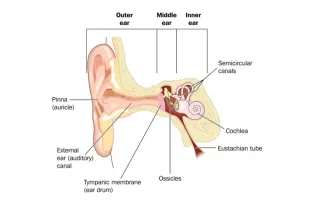Overview
Otitis media is inflammation or infection of the middle ear, a common condition, particularly in children. It can cause significant discomfort and may lead to hearing problems if not properly managed.
Types of Otitis Media:
- Acute Otitis Media (AOM): A sudden onset of infection in the middle ear, often associated with pain, fever, and hearing loss.
- Otitis Media with Effusion (OME): The presence of fluid in the middle ear without symptoms of an acute infection. It often follows an episode of AOM.
- Chronic Otitis Media: Persistent inflammation or infection of the middle ear, which can lead to continuous discharge and potential damage to the ear structures.
Symptoms:
- Ear pain, often severe and worsening at night
- Hearing difficulties
- Fluid drainage from the ear
- Fever
- Irritability and difficulty sleeping in children
- Tugging or pulling at the ear
- Balance problems
Causes:
Otitis media is usually caused by bacterial or viral infections that lead to the accumulation of fluid behind the eardrum. Common pathogens include Streptococcus pneumoniae, Haemophilus influenzae, and respiratory viruses. Factors contributing to otitis media include:
- Upper Respiratory Infections: Colds and sinus infections can cause inflammation and blockage of the eustachian tubes.
- Allergies: Allergic reactions can lead to eustachian tube dysfunction.
- Eustachian Tube Dysfunction: Blockage or dysfunction of the eustachian tubes can prevent proper drainage of fluids from the middle ear.
- Environmental Factors: Exposure to smoke and high levels of air pollution can increase the risk.
Diagnosis:
Diagnosis involves a physical examination, including the use of an otoscope to look inside the ear for signs of infection and fluid buildup. Additional tests may include:
- Tympanometry: Measures the movement of the eardrum in response to air pressure changes.
- Audiometry: Tests hearing to determine the extent of hearing loss.
Treatment:
- Observation: Mild cases of AOM may resolve without treatment. Observation is often recommended for 48 to 72 hours in children over six months.
- Antibiotics: Prescribed for bacterial infections, especially in severe cases or when symptoms persist. Common antibiotics include amoxicillin.
- Pain Management: Over-the-counter pain relievers like paracetamol or ibuprofen can help reduce pain and fever.
- Surgical Intervention: In cases of chronic otitis media or recurrent infections, procedures like myringotomy (inserting a tube into the eardrum) may be recommended to drain fluid and prevent future infections.
Complications:
If left untreated, otitis media can lead to serious complications such as:
- Hearing loss
- Perforation of the eardrum
- Mastoiditis (infection of the mastoid bone)
- Meningitis (infection of the membranes surrounding the brain)
- Cholesteatoma (abnormal skin growth in the middle ear)
Prevention:
- Vaccination: Immunizations, such as the pneumococcal and influenza vaccines, can reduce the risk of infections that may lead to otitis media.
- Breastfeeding: Breastfeeding for at least six months can help reduce the risk of ear infections in infants.
- Avoiding Smoke Exposure: Reducing exposure to tobacco smoke and other pollutants can lower the risk of otitis media.


